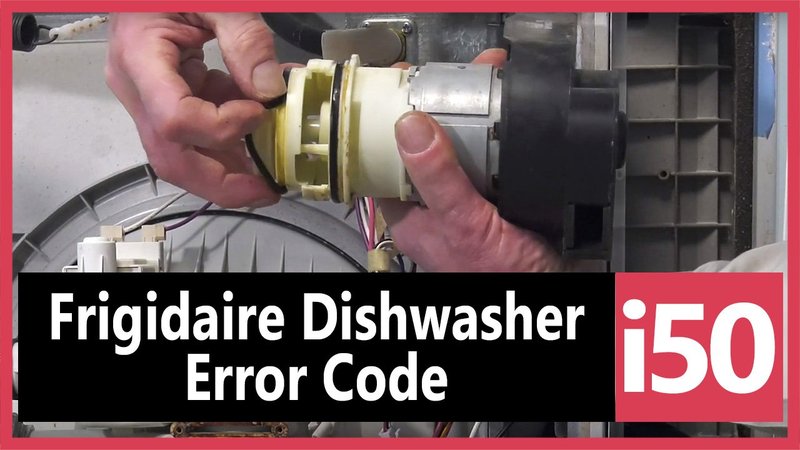
When your dishwasher displays Error Code F2, it’s essentially trying to have a conversation with you — albeit a bit one-sided and technical. This code typically indicates a drainage problem, meaning the water that should be drained isn’t escaping as it should. Think of it like a bathtub that refuses to empty after a bath; something’s preventing the water from going down the drain. What could it be? Well, anything from a kinked hose to a faulty pump could be at fault. This error doesn’t always mean you have a major issue, but understanding when it’s time to call in a professional is crucial to prevent more significant damage.
Understanding Error Code F2 on Your Frigidaire Dishwasher
First things first, let’s dive into what Error Code F2 signifies. This code is your dishwasher’s way of saying there’s a problem with draining water. Imagine pouring water into a bucket that has no hole to let it out; eventually, it’s going to overflow. In the world of dishwashers, if water can’t drain properly, it can lead to leaks, unpleasant odors, or even stop the machine from working at all.
Frigidaire dishwashers are pretty sophisticated and come with self-diagnostics that help identify issues early on. The F2 code triggers when the appliance detects that water is not being pumped out effectively. Common causes could be anything from a blocked drain hose — think a garden hose with a crimp — to a malfunctioning pump. Even debris lodged in the drain could be to blame. While some issues might require a bit of DIY tinkering, others may need the skilled hands of a technician.
Now, you might be thinking, “Can’t I just ignore it and hope it goes away?” Unfortunately, ignoring the problem could lead to more severe issues. The water that doesn’t drain could damage other components, causing bigger headaches and more costly repairs down the road. So, tackling the issue sooner rather than later is always the best approach.
Signs It’s Time to Call a Technician
Sure, you’re handy with a screwdriver, but there are times when calling a technician is the smartest move. Let’s look at the signs that it’s time to get professional help. First and foremost, if you’ve tried the basics — checking for obvious blockages or kinks in the hose — and the issue persists, it could be something more complex under the hood. The average Joe isn’t equipped to diagnose or fix a faulty pump or motor.
Another sign to call in the pros is if you’re experiencing leaks. Water pooling around your dishwasher can damage your floors and cabinets, and it’s often a sign that water isn’t draining as it should, possibly due to a more severe underlying issue. Additionally, if you hear unusual sounds like grinding or the dishwasher doesn’t start at all, it’s time to get an expert’s opinion. These noises can indicate that internal parts are struggling or failing, which a technician needs to address.
Got a newer model with a warranty still active? That’s even more reason to call a technician. Tampering with your appliance might void the warranty, costing you more in the long run. Plus, the expertise of a technician ensures the issue is resolved properly, giving you peace of mind and potentially saving you from future dishwasher drama.
Preventative Tips to Avoid Error Code F2
No one wants to face the same problem over again. So, how can you prevent the Error Code F2 from making an unwelcome return? Regular maintenance is key. Just like you wouldn’t let leaves clog your gutters, don’t let food debris block the dishwasher’s drain. Make it a habit to rinse plates well before loading them to prevent clogs.
Another pro-tip is to check the dishwasher’s drain hose occasionally. Ensure it’s not crimped or bent, as this can prevent proper drainage. It’s much like making sure a drinking straw isn’t bent when trying to sip a drink — a clear pathway is crucial. Additionally, running an occasional cleaning cycle with vinegar can help break down any build-up that might cause drainage issues.
Lastly, being attentive to your dishwasher’s sounds and performance can alert you to potential problems early. It’s much like catching a flat tire before it completely deflates. By staying proactive, you can avoid the dreaded Error Code F2 and ensure your dishwasher keeps running smoothly.
In conclusion, Error Code F2 is your dishwasher’s way of asking for a little extra attention. While some issues can be fixed with a quick DIY check-up, don’t shy away from calling a technician when needed. Remember, a stitch in time saves nine, and addressing small problems now can prevent larger ones later. Keep these tips in mind, and you’ll be back to enjoying stress-free dishwashing in no time.